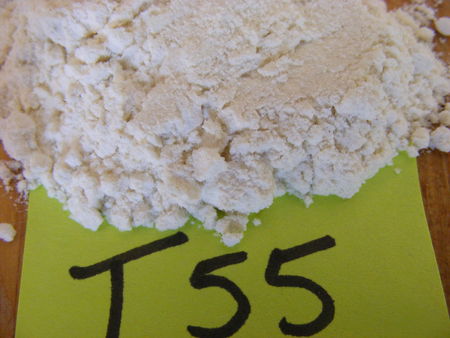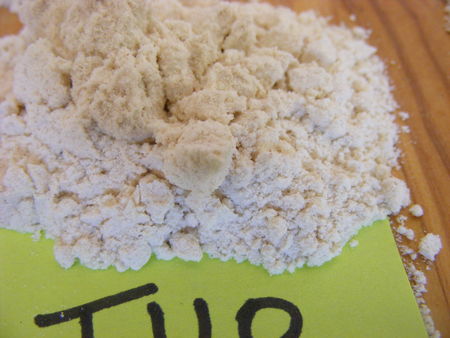French wheat flour
Ce billet est rédigé en anglais car le public visé en celui des anglophones qui se posent de multiples questions sur la farine française. J'ai déjà publié un article en français sur des farines ICI.
French Wheat Flours
Sharing recipes across the Atlantic is always a very big challenge. Our flours are not milled the same and their protein content is never quite the same. Not to mention the different wheat varieties. In North American, bakers have a wide range of choice in wheat types because of the very different climates available. Hard, soft, winter, spring, a blend of a few.
In France our flour is mostly soft winter or spring wheat and therefore can be more of a challenge to make bread with. I have read some articles that explain that bakers often buy flour mixes that include American hard wheat flour, in order to facilitate their production.
As an at home bread baker, I only buy organic, French flour. I buy it at our biocoop that has a very high standard in organic goods. This obviously limits the choices in types of wheat, but I find that quality of the flour for bread baking absolutely extraordinary in taste and the final texture of the bread. The supermarket varieties are of basically no interest for "serious" bakers.
French wheat flour comes in a range of « T » numbers. These numbers are given according to the ash content in 100g of dry mass of the flour.
I have read and heard different opinions as to the uses of these flours, so I can only explain how I, personally use them.
T45 – a nice, white pastry flour. It doesn’t contain enough gluten to make bread. (I never use it)
T55 – the French baguette is made from this flour than contains from around 10 -11% protein. I don’t use it very often, except for sweet dough if I want a very light texture.
T65 – my « bread flour » with around 11,5% protein (but that varies according to the brand). It isn’t completely white, but gives a beautiful, creamy color to the crumb and a wonderful flavor. I also do all my basic baking (pastries, cakes, cookies, etc) with this flour.
T80 – « bis » flour, meaning that it isn’t white, but it isn’t whole wheat. You can see specks in it, but bread made with it remains fairly light in color and texture. Many bakers call it their favorite flour to work with.
T110 – a light whole-wheat flour that is wonderful on its own or mixed with lighter flour. It gives exceptional color and flavor to bread and is a great compromise when a very « healthy » bread is sought after, but you don’t want a heavier, whole-wheat bread.
T150 – Whole wheat flour.
T170 – Graham flour, the most whole of the whole wheat. I made Graham crackers with this the other day and it was incredible (see HERE if interested in seeing)!
So, there you have the basic wheat flours. Now what ?
There are no exact rules for translation of a recipe, but I have some suggestions that are worth trying. First of all, the protein content can be duplicated. If you are looking at a recipe that calls for T65, try a blend of All-Purpose and Bread flour. Look at the protein content and decide then on the proportions. The percentages can change drastically depending on the brands, so be careful. King Arthur un-bleached All-Purpose flour has 11,7% protein which is higher than the T65 !
Another possibility is using an All-purpose flour, with some bread flour and a bit of high-extraction flour or white whole-wheat. Or just All-purpose and high-extraction/white whole-wheat.
This same blend with a modification in the proportions would give you a close T80 as well. Maybe half high-extraction and half All-Purpose. Or the blend of the three with more high-extraction flour/white whole-wheat than for the T65.
The reality is, that unless you have the opportunity to work with French flours and American ones, it is very difficult to find perfection. But, then what’s perfection ?
In all the recipes I’ve followed from my great bread books, I have always managed to get the results I’m looking for by playing around with the quantities of flour. I never put the whole amount of flour in just in case, and then as I stir, I add more. I particularly like recipes that explain the texture of the dough. That is always a sure win. I don’t like recipes that don’t explain anything and just give proportions, unless of course, it is a type of bread that I know. I haven’t had any trouble with Hamelman’s Bread because his breads are artisanal hearth loaves (at least the ones I have attacked and I admit, I usually do sourdough), so I know what I’m looking for. My main difficulties have emerged with yeasted bread, especially the sandwich type loaves often made with American Bread flour. I rarely make them, so it doesn’t really matter, I guess. I usually just try adding Vital gluten.
But any type of bread reminds me of the San Francisco sourdough that "can't be made anywhere else". It isn't only the flour, but the yeast, the water, the air that each have a role in the bread making process. So, you just have to fiddle around with a recipe to come up with something to your satisfaction and not necessarily a stereotype model bread.
One thing I can recommend is always, always choosing very high quality, fresh flour. It makes all the difference in the world. And for whole wheat, use organic, because there are a whole bunch of pesticides trapped in the grain that just get ground up and baked with the bread. Scary thought.
With some luck, my dad will bring me some Canadian flour over this autumn and I can try my hand. I may just have some helpful info about the handling compared to French flours.
I hope this post will evolve as readers share their experiences and experiments. Feel free to leave me a note or write to my e-mail. I’ll add the info as it comes in.
Happy Baking!
(Bâtards baked using the sourdough baguette recipe)


/https%3A%2F%2Fprofilepics.canalblog.com%2Fprofilepics%2F1%2F6%2F165160.jpg)









/https%3A%2F%2Fstorage.canalblog.com%2F68%2F93%2F420216%2F93641916_o.jpg)
/https%3A%2F%2Fstorage.canalblog.com%2F18%2F92%2F420216%2F93564671_o.jpg)
/https%3A%2F%2Fstorage.canalblog.com%2F66%2F49%2F420216%2F90496918_o.jpg)
/http%3A%2F%2Fp5.storage.canalblog.com%2F51%2F79%2F194702%2F83035039_p.jpg)
/https%3A%2F%2Fstorage.canalblog.com%2F39%2F21%2F420216%2F29060953_o.jpg)